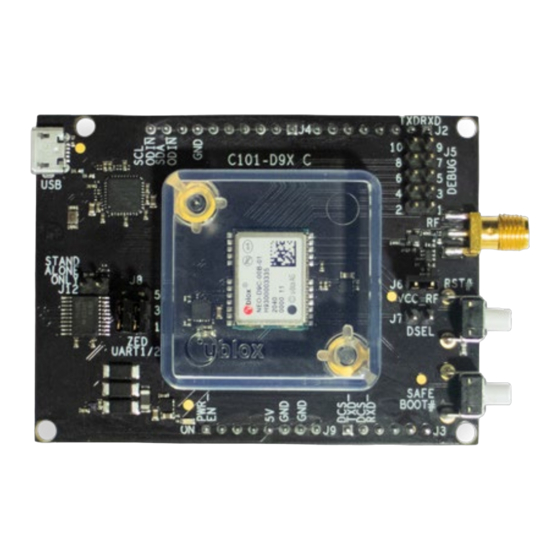
Table of Contents
Advertisement
Quick Links
Advertisement
Table of Contents

Summary of Contents for Ublox C101-D9C
- Page 1 C101-D9C Application board (rev. C) User guide Abstract This document explains the use of C101-D9C application board. The C101-D9C board enables customers to evaluate QZSS L6 correction services with the NEO-D9C correction data receiver. UBX-21009111 - R02 www.u-blox.com C1-Public...
-
Page 2: Document Information
C101-D9C - User guide Document information Title C101-D9C Subtitle Application board (rev. C) Document type User guide Document number UBX-21009111 Revision and date 17-Jan-2022 Disclosure restriction C1-Public This document applies to the following products: Product name Type number Firmware version... -
Page 3: Table Of Contents
2.1 Components ..............................5 2.2 Jumpers ................................ 6 C101-D9C standalone operation ....................7 C101-D9C operation with C099-F9P ..................... 9 4.1 C101-D9C/C099-F9P via Arduino shield ....................10 Appendix ..............................12 Glossary .............................. 12 Antenna specification (L1/L2/E5b/L6) ..................12 C101-D9C schematics ........................13 Related documentation ......................... -
Page 4: Introduction
C101-D9C - User guide Introduction The C101-D9C board is a convenient tool that allows customers to become familiar with the u-blox NEO-D9C QZSS L6 receiver. The board provides facilities for evaluating the product and demonstrating its key features. NEO-D9C is a QZSS L6 receiver that brings QZSS Centimeter Level Augmentation Service (CLAS) support to u-blox GNSS modules, enabling centimeter-level navigation. -
Page 5: C101-D9C Product Overview
C101-D9C product overview 2.1 Components C101-D9C houses the NEO-D9C QZSS L6 receiver. The board is powered from the USB cable connection or via Arduino shield. The main components of the board are listed below and shown in Figure 1 and Figure 2: •... -
Page 6: Jumpers
UART2 of the C099-F9P, when connected via the Arduino shield (refer to section 4.1 for further details). Figure 3: C101-D9C jumpers overview For further details, see the C101-D9C schematic in Appendix C. UBX-21009111 - R02 C101-D9C product overview Page 6 of 17... -
Page 7: C101-D9C Standalone Operation
C101-D9C - User guide C101-D9C standalone operation This section provides some quicksteps to enable NEO-D9C standalone operation and connecting via u-center (see u-center user guide [3]). • Connect the supplied L6 band antenna to the RF SMA connector. • Connect the USB to a Windows PC, this will power the board. The FTDI and USB drivers will be installed automatically from Windows Update when you connect the board for the first time. - Page 8 C101-D9C - User guide • Poll or enable the UBX-RXM-QZSSL6 message to check the received correction data. Figure 7: UBX-RXM-QZSSL6 message For further details regarding the UBX-RXM-QZSSL6 message, see the related Interface description [4]. UBX-21009111 - R02 C101-D9C standalone operation...
-
Page 9: C101-D9C Operation With C099-F9P
C101-D9C - User guide C101-D9C operation with C099-F9P It is possible to use the C101-D9C board together with C099-F9P. Figure 9 shows how to interface the C101-D9C board with the C099-F9P board. Two types of connections are available: • USB interface (through PC) •... -
Page 10: C101-D9C/C099-F9P Via Arduino Shield
C101-D9C - User guide 4.1 C101-D9C/C099-F9P via Arduino shield Figure 9 shows the placement of the Arduino connectors on the C101-D9C board and Figure 10 shows how to physically connect the C099-F9P board to the C101-D9C board via the Arduino shield. Jumper J18 on the C099 board is needed for the ZED-F9P to receive the correction data on UART1 port. - Page 11 C101-D9C - User guide Depending on the position of the jumper J8 on the C101-D9C board (as shown following) the ZED-F9P housed on the C099-F9P board will receive the correction data on the UART1 or UART2: The ZED-F9P receives the correction data The ZED-F9P receives the correction data on UART1.
-
Page 12: Appendix
C101-D9C - User guide Appendix A Glossary Abbreviation Definition FTDI Future Technology Device International Geostationary Earth Orbit Light Emitting Diode Low Noise Amplifier Radio Frequency QZSS Quasi Zenith Satellite System RHCP Right Hand Circular Polarized Subminiature version A UART Universal Asynchronous Receiver Transmitter... -
Page 13: C C101-D9C Schematics
C101-D9C - User guide See the NEO-D9C Integration manual [1] for further details. C C101-D9C schematics The following pages show the complete schematics for the C101-D9C evaluation board. UBX-21009111 - R02 Appendix Page 13 of 17 C1-Public... - Page 14 C101-D9C - User guide UBX-21009111 - R02 Appendix Page 14 of 17 C1-Public...
- Page 15 C101-D9C - User guide UBX-21009111 - R02 Appendix Page 15 of 17 C1-Public...
-
Page 16: Related Documentation
C101-D9C - User guide Related documentation NEO-D9C Integration manual, UBX- 21031631 ZED-F9P Integration manual, UBX-18010802 u-center User guide, UBX-13005250 u-blox D9 QZS 1.01 Interface description, UBX- 21031777 C099 AppBoard User guide, UBX-18055649 ☞ For product change notifications and regular updates of u-blox documentation, register on our website, www.u-blox.com. -
Page 17: Contact
C101-D9C - User guide Contact For complete contact information, visit us at www.u-blox.com. u-blox Offices North, Central and South America Headquarters Asia, Australia, Pacific Europe, Middle East, Africa u-blox America, Inc. u-blox Singapore Pte. Ltd. u-blox AG Phone: +1 703 483 3180...











Need help?
Do you have a question about the C101-D9C and is the answer not in the manual?
Questions and answers